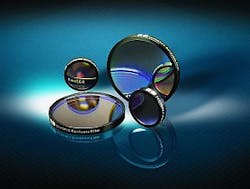Bandpass filters from Edmund Optics available in traditional- and hard-coated versions
Bandpass interference filters are used to selectively transmit a narrow range of wavelengths while blocking others. They are available as “traditional” coated filters and high-performance “hard” coated filters, which are fabricated via an advanced plasma reactive sputtering platform. Custom hard coated filters, with optical densities greater than 6.0, transmission greater than 90%, and edge steepness less than 0.5%, can be rapidly
developed for OEM instrumentation.
Edmund Optics
Barrington, NJ
[email protected]
-----
PRESS RELEASE
Hard Coated Bandpass Interference Filters
Available in UV, VIS, and IR Center Wavelengths
10 - 80nm Bandwidths Available
Hard and Soft Coating Options Available
Bandpass Interference Filters are used extensively in a variety of biotech, biomedical, and quantitative chemical applications to selectively transmit a narrow range of wavelengths while blocking all others. Interference filters are widely used in instrumentation for clinical chemistry, environmental testing, colorimetry, elemental and laser line separation, flame photometry, fluorescence, immunoassays, etc. In addition, interference filters are used to select discrete spectral lines from arc or gas discharge lamps (Hg, Xe, Cd, etc.) and to isolate a particular line from Ar, Kr, Nd:YAG, and other lasers. They are often used in conjunction with laser diodes and LEDs. Our filters are available in two types – low-cost "Traditional” Coated Filters, and high-performance “Hard” Coated Filters.
Hard Coated Filters
Hard Coated filters are fabricated utilizing our state-of-the-art Advanced Plasma Reactive Sputtering coating platform. This technology allows us to produce single-substrate filters with deeper blocking, higher transmission, and steeper slopes than what are available from our soft coated filters. While the filters are somewhat more expensive, the dense coating design prevents filter degradation. Thus, the long-term cost of ownership of our hard-coated filters is significantly reduced. Custom hard coated filters, with optical densities >6.0, transmission >90%, and edge-steepness of <0.5%, can be rapidly developed for OEM instrumentation.
Technology & Products / Optical Components
Filter transmission nearly doubles using dual-magnetron sputtering
Conventional narrowband interference filters are fabricated in two steps. The first determines center wavelength and bandwidth (deposition of up to 50 layers each of quarter-wave and half-wave optical thickness dielectric materials of alternating high and low refractive indices). The second determines blocking capability (metallic film layers and additional colored layers on an alternate substrate). The two sections are then scribed, laminated, cut, and mounted. Unfortunately, these traditional blocking layers reduce transmission at all wavelengths, limiting the overall transmission to 25-50%, depending on center wavelength.
But sputtered coatings--dielectric films of arbitrary thickness (up to 200 layers) deposited on a single substrate--eliminate complex cavity designs and epoxy layers, enabling excellent transmission up to 90% with steep edges and broad-spectrum blocking for greatly improved signal-to-noise ratio. While the most common sputtering method is Ion Beam Sputtering (IBS), Edmund Optics (Barrington, NJ) uses a more cost-effective dual-magnetron sputtering technique with a 0.5 nm/s deposition rate that is five times faster than IBS, enabling environmentally stable, shift-free coatings. Edmund offers six families of hard-sputtered filters including bandpass, edge, and notch types, with lifetimes exceeding 10 years (compared to 1-3 years for conventional filter designs). Contact Gregg Fales at [email protected].
